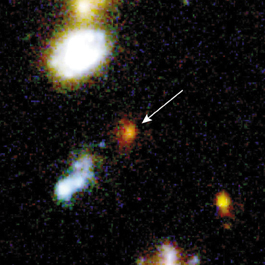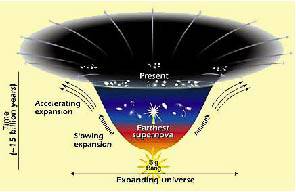WORKING TOGETHER, NERSC AND THE HUBBLE SPACE TELESCOPE SET AN ASTRONOMICAL RECORD
Berkeley Lab astrophysicist Peter Nugent, working with Adam Riess of the Space Telescope Science Institute, used an IBM SP supercomputer at NERSC to analyze data from an exploding star that had been caught once on purpose and twice by accident by NASA's Hubble Space Telescope.
Nugent's analysis confirmed that SN 1997ff, with a redshift of 1.7, is the oldest and most distant Type Ia supernova ever seen. Riess and Nugent presented their findings at a press conference held at NASA headquarters in Washington on April 2, where they discussed the importance of their discovery for cosmology.
"This supernova is consistent with the cosmological model of an accelerating universe, a universe mostly filled with dark energy," Nugent says. "It argues against the notion that observations of distant Type Ia supernovae may be systematically distorted by intervening gray dust or the chemical evolution of the universe."
Moreover, says Nugent, "the supernova is so ancient that it allows us to glimpse an era when matter in the universe was still relatively dense and expansion was still slowing under the influence of gravity. More recently the dark energy has begun to predominate and expansion has started to speed up."
|
|
|
| In the early universe matter was dense and expansion was slowing. But as matter drifted apart, its density decreased. Dark energy prevailed, and expansion began to accelerate. | |
The farthest candle
Two international groups of astronomers and physicists-the Supernova Cosmology
Project, headquartered at Berkeley Lab and led by Saul Perlmutter of the
Physics Department, and the High-Z Supernova Search Team, led by Brian
P. Schmidt at the Australian National University-discovered the accelerating
expansion of the universe by using Type Ia supernovae as "standard
candles" to measure cosmological parameters.
Type Ia spectra and light curves (their rising and falling brightness over time) are all nearly alike, and they are bright enough to be seen at very great distances. With a redshift (or z) of about 1.7, says Nugent, "supernova 1997ff is some 11.3 billion years old, much older-and much fainter-than the previous record of z equal 1.2, which corresponds to an age of about 9.8 billion years old."
He adds that a supernova at redshift 1.7 "is too far away to have been visible from the surface of the Earth. Only a space-based telescope could have found it."
Faint as it is, SN 1997ff is actually brighter than its extreme redshift would suggest. "This drives a stake through the heart of alternatives to the accelerating universe," said University of Chicago cosmologist Michael Turner at the NASA press conference.
Because the theory of the accelerating universe is based on observations that distant supernovae are dimmer and thus farther away than their redshifts might otherwise suggest, some critics had suggested that maybe Type Ia supernovae in the early universe were just dimmer to begin with, or that some form of "gray dust," like a neutral density filter on a camera, filters their light and only makes them seem dim.
But SN 1997ff dates from a time before acceleration, so early that the expansion of the universe was still slowing under the influence of gravity. Instead of being dimmer than expected, it is brighter, an effect that rules out both gray dust filters and the inherent dimness of the most ancient supernovae.
The one that almost got away
SN 1997ff was first found, on purpose, by Ron Gilliland of the Space Telescope Science Institute and Mark Phillips of the Carnegie Institute of Washington, during the last week of December, 1997. Gilliland and Phillips turned the Hubble Space Telescope on the same patch of sky recorded in the renowned Hubble Deep Field of typical galaxies, looking for bright spots which, after spurious or doubtful signals had been rigorously eliminated, might prove to be supernovae. They found two good candidates.
Gilliland and Phillips asked Nugent to help them determine what these discoveries implied for the rate at which high-redshift supernovae might occur in the universe as a whole. The three published a report in 1999 suggesting that one of their two candidates, SN 1997ff, was probably a Type Ia with a redshift greater than z = 1.32. Because it had been observed in only one range of frequencies, however, the uncertainties were too great to use the supernova for cosmological estimates.
|
|
 |
| Supernova 1997ff was found the first time by a deliberate search of the Hubble Deep Field-then found again three weeks later, this time by happy accident. | |
At high redshifts, much of an astronomical object's characteristic spectrum is shifted into the infrared. Without additional infrared observations, no useful cosmological information could be derived from SN 1997ff, nor could its type be positively identified. It seemed unlikely that anyone had made such observations.
Enter serendipity. Only 25 days after the initial observation, Rodger Thompson of the University of Arizona had begun doing tests of a small portion of the Hubble Deep Field with NICMOS, an instrument aboard the space telescope that makes images in the near infrared. Although Thompson had not been looking for supernovae, many of his images accidentally included SN 1997ff and its host galaxy.
"Twenty-five days later may seem like a long time, but highly redshifted objects are moving away from us so fast that time dilation is large," Nugent remarks. "At a redshift of 1.7, three and a half weeks in our frame of reference is only about nine days of elapsed time for the supernova itself."
Six months later another set of infrared images of the same region, made by Mark Dickinson of the Space Telescope Science Institute, caught the now greatly faded supernova and its host galaxy once again. Once more, luck had provided a missing piece of the puzzle: by digitally subtracting the new image of the host galaxy from images made when the supernova was bright, Nugent proposed to Dickinson, much of the remaining uncertainty about the supernova and its host could be eliminated.
He had no takers until July of last year, however, when Adam Riess, independently intrigued by the accumulating data, queried Nugent about doing cosmology on an unnamed supernova at a redshift "around 1.65." There was only one such supernova; soon Riess and Nugent were collaborating.
"Adam had the monumental task of reducing the observed NICMOS infrared data," said Nugent, "while I concentrated on comparing the reduced data to known supernovae and various sets of cosmological parameters." By painstakingly eliminating other possibilities, they determined that SN 1997ff was almost certainly a Type Ia supernova at a redshift of 1.7, first seen eight days after it exploded.
"Now we could do the cosmology," Nugent says.
If the luck holds, what comes next?
SN 1997ff supports the model of a universe consisting of about one third matter and ordinary energy and about two thirds "dark energy," which acts to overcome gravity. Most important, says Nugent, SN 1997ff proves that while the most distant supernova currently cannot be seen from ground telescopes, they can be observed from space-and they can provide vital information about the most basic cosmological questions, including, perhaps, the nature of the dark energy itself.
"The results from SN 1997ff are one of the best arguments for the SNAP satellite," Nugent says. SNAP- for SuperNova/ Acceleration Probe- is a multi-institution, multi-agency proposal led by Saul Perlmutter and Michael Levi of the Lab's Physics Division. It would fly a 2-meter telescope and employ a CCD camera far larger and more sensitive than any previous astronomical imager, especially in the near infrared.
The discovery of SN 1997ff underscores the role of luck in science - although as Michael Turner paraphrased Louis Pasteur, "Serendipity favors the prepared mind"-it also illustrates the value of cooperation among agencies such as NASA and the Department of Energy.
Not to mention among rival groups: Peter Nugent is a member of the Supernova Cosmology Project, and Adam Riess is a member of the High-Z Supernova Search Team.
To see the recorded press conference, or for more information about SN 1997ff, visit http://oposite.stsci. edu/pubinfo/pr/2001/09/ - end -
|
|||||||||
